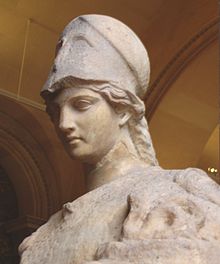|
Greek city of Thessalonica in Macedonia
Bronze 17mm (6.91 grams) Struck 187-31 B.C.
Reference: SNG ANS 770
Head of Athena wearing Corinthian helmet.
ΘEΣΣAΛO / NIKHΣ above and below horse prancing right.
You are bidding on the exact item pictured,
provided with a Certificate of Authenticity and Lifetime Guarantee of
Authenticity.
Athena or Athene
(Latin:
Minerva), also referred to as
Pallas Athena, is the goddess of war, civilization, wisdom, strength,
strategy, crafts, justice and skill in
Greek mythology.
Minerva,
Athena’s Roman
 incarnation, incarnation,
embodies similar attributes. Athena is also a shrewd companion of
heroes and the
goddess of
heroic endeavour. She is the
virgin patron of
Athens. The Athenians built the
Parthenon on the Acropolis of her namesake
city, Athens, in her honour (Athena Parthenos). Athena’s cult as the patron of
Athens seems to have existed from the earliest times and was so persistent that
archaic myths about her were recast to adapt to cultural changes. In her role as
a protector of the city (polis),
many people throughout the Greek world worshiped Athena as Athena Polias
(“Athena of the city”).
Athens and Athena bear etymologically connected
names.
The city was founded around
315 BC by the
King
Cassander of Macedon, on or near the site of the ancient town of
Therma and
twenty-six other local villages. He named it after his wife
Thessalonike, a half-sister of
Alexander the Great. She gained her name (“victory of Thessalians”: Gk
nikē “victory”) from her father,
Philip II, to commemorate her birth on the day of his gaining a victory over
the
Phocians, who were defeated with the help of
Thessalian horsemen, the best in Greece at that time. Thessaloniki developed
rapidly and as early as the
2nd
century BC the first walls were built, forming a large square. It was an
autonomous part of the Kingdom of
Macedon, with its own parliament where the King was represented and could
interfere in the city’s domestic affairs.
Roman
era
After the fall of the kingdom of Macedon in
168 BC,
Thessalonica became a city of the
Roman Republic. It grew to be an important trade-hub located on the
Via
Egnatia, the
Roman road connecting
Byzantium
(later
Constantinople), with
Dyrrhachium
(now
Durrës in
Albania), and
facilitating trade between Europe and Asia. The city became the capital of one
of the four Roman districts of Macedonia; it kept its privileges but was ruled
by a
praetor
and had a Roman garrison, while for a short time in the
1st
century BC, all the Greek provinces came under Thessalonica (the Latin form
of the name). Due to the city’s key commercial importance, a spacious harbour
was built by the Romans, the famous Burrowed Harbour (Σκαπτός Λιμήν) that
accommodated the town’s trade up to the eighteenth century; later, with the help
of silt deposits from the river
Axios, it was
reclaimed as land and the port built beyond it. Remnants of the old harbour’s
docks can be found in the present day under Odos Frangon Street, near the
Catholic Church.
Thessaloniki’s
acropolis,
located in the northern hills, was built in
55 BC after
Thracian raids in the city’s outskirts, for security reasons.
The city had a
Jewish colony, established during the
first
century, and was to be an early centre of
Christianity. On his second missionary journey,
Paul
of Tarsus, born a Hellenized Israelite, preached in the city’s synagogue,
the chief synagogue of the Jews in that part of Thessaloniki, and laid the
foundations of a church. Other Jews opposed to Paul drove him from the city, and
he fled to
Veroia. Paul wrote two of his
epistles to the Christian community at Thessalonica, the
First Epistle to the Thessalonians and the
Second Epistle to the Thessalonians.
Thessaloníki acquired a patron saint,
St. Demetrius, in 306. He is credited with a number of miracles that saved
the city, and was the Roman
Proconsul
of Greece under the anti-Christian emperor
Maximian,
later martyred at a Roman prison where today lies the
Church of St. Demetrius, first built by the Roman sub-prefect of
Illyricum Leontios in 463. Other important remains from this period include
the
Arch and Tomb of Galerius, located near the centre of the modern city.
|




 incarnation,
incarnation, 


